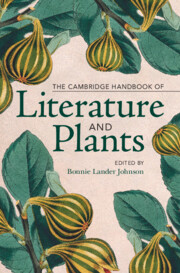Book contents
- The Cambridge Handbook of Literature and Plants
- The Cambridge Handbook of Literature and Plants
- Copyright page
- Contents
- Figures
- Contributors
- Introduction
- Part I Historical Periods
- Chapter 1 The Ancient World
- Chapter 2 Inspective Fruits
- Chapter 3 Plant Lives in the Literatures of Medieval England
- Chapter 4 Plant-Lore in the Botanical Renaissance
- Chapter 5 Literary Plants
- Chapter 6 Portraits of Plants
- Part II Anglophone Literary Forms
- Part III Global Regions
- Select Bibliography
- Index
Chapter 3 - Plant Lives in the Literatures of Medieval England
from Part I - Historical Periods
Published online by Cambridge University Press: 06 February 2025
- The Cambridge Handbook of Literature and Plants
- The Cambridge Handbook of Literature and Plants
- Copyright page
- Contents
- Figures
- Contributors
- Introduction
- Part I Historical Periods
- Chapter 1 The Ancient World
- Chapter 2 Inspective Fruits
- Chapter 3 Plant Lives in the Literatures of Medieval England
- Chapter 4 Plant-Lore in the Botanical Renaissance
- Chapter 5 Literary Plants
- Chapter 6 Portraits of Plants
- Part II Anglophone Literary Forms
- Part III Global Regions
- Select Bibliography
- Index
Summary
This chapter considers the shared experiences of humans and plant-life in the vernacular traditions of medieval England c. 700–1500, considering their representation in Old English and Old Norse, Middle English, and associated literatures. In particular, it focuses on those instances in which plants, principally trees, undergo physical and emotional suffering, highlighting the ways in which these articulate the experience of individual humans and broader kinship groups. In several instances, whether directly or indirectly, these literary plant-lives also serve didactic purposes, and are used to express religious, folkloric, and/or gnomic wisdom, ranging from the elevated to the everyday. Thus, The Dream of the Rood and The History of the Holy Rood narrate the role of the rood-tree in the crucifixion of Christ and human spiritual history, whilst those of Le Fresne and The Floure and the Leafe reflect moral and social preoccupations and contemporary belief. Raising questions about the literary-cultural exploitation of plant-life to represent medieval human experience, this chapter considers the inescapability of arboreal metaphor – a consequence not only of the shared world of humans and trees, but of our shared vulnerabilities.
- Type
- Chapter
- Information
- The Cambridge Handbook of Literature and Plants , pp. 51 - 67Publisher: Cambridge University PressPrint publication year: 2025

